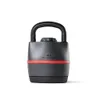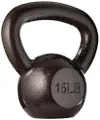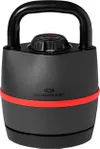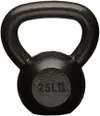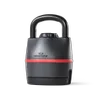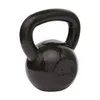
Revamp your single-arm overhead press and build upper body strength using this kettlebell press drill. And oh boy, does it test you.
Shared as a YouTube short, the exercise, also called “the band of distraction press’ by Kettlebell Kings Austin (not ominous at all), will put your shoulders, chest, traps and triceps through even more resistance and challenge your core stability.
Practicing the drill could develop better pressing power simply by wrapping a resistance band around a kettlebell on the floor and a kettlebell you’ll lift. And hey presto, you’ve got yourself a souped-up pressing variation.
If you haven’t yet invested in your gym equipment, we recommend the best kettlebells and resistance bands for your home workouts, and then you'll have everything you need to learn how to do the overhead press drill and why we love it.
What is the kettlebell press strength band drill?
The drill, posted by Kettlebell Kings, will increase the resistance your muscles must work against to achieve the lift using one resistance band. We recommend choosing a lightweight band first to ensure good form, then slowly increase the resistance as you get stronger.
You’ll work one side of the body at a time, which can help you focus on isolating your left and right sides without a stronger or more dominant muscle group taking over, which is a common problem with using barbells for the overhead press.
Barbells are brilliant for maximal loading but not so much for ironing out the inevitable weaknesses and instabilities we unknowingly build in our bodies over time.
Get instant access to breaking news, the hottest reviews, great deals and helpful tips.
To do the drill, wrap a resistance band around a heavy kettlebell and place it on the floor next to your right foot. Next, wrap the other end of the band around the kettlebell you plan to lift and perform the kettlebell overhead press on your right side, as you usually would — learn how to do an overhead press if you’re uncertain about the finer cueing details. Complete your reps, then switch to your left side.
The kettlebell on the ground should always be on the same side as the arm you’re pressing with, which creates a straight, slightly diagonal line from bell to bell.
Several things can go wrong with this exercise, which could put undue pressure on the shoulder joint and the rotator cuff muscles — a group of four muscles that support and stabilize the shoulders during movement.
Keep a close eye on your form, using a spotter or mirror if you need to. Your arm should remain close to your body without allowing the bell to travel away from you — check the weight and your wrist stack over your shoulder with your palm facing away from you (using an overhand grip) and the bell resting at your forearm.
As you press, ensure you fully punch your arm overhead and avoid half reps. Your elbow shouldn’t ever maneuver through the middle of the band. Instead, it’ll sit toward the outside of your upper arm.
There are no prescribed sets or reps for this drill, so program according to your ability and how you plan to use it. We recommend 3-4 sets of 8-12 reps per arm as a starting point, going heavier if used as a standalone drill or as part of your upper body strength program.
If you plan to use it as a mobility or warm-up drill, you don’t want to fatigue the muscles too early, so go lighter to warm the muscles and practice for fewer sets or reps.
More from Tom's Guide
- I tried the 3-minute CrossFit kipping exercise every day for a week — here are my results
- Forget the gym — build a stronger chest and arms with this 5-move dumbbell workout
- Forget the gym — you just need a pair of dumbbells and 5 exercises to sculpt your shoulders

Sam Hopes is a level 3 qualified trainer, a level 2 Reiki practitioner and fitness editor at Tom's Guide. She is also currently undertaking her Yoga For Athletes training course.
Sam has written for various fitness brands and websites over the years and has experience across brands at Future, such as Live Science, Fit&Well, Coach, and T3.
Having coached at fitness studios like F45 and Virgin Active and personal trained, Sam now primarily teaches outdoor bootcamps, bodyweight, calisthenics and kettlebells.
She also coaches mobility and flexibility classes several times a week and believes that true strength comes from a holistic approach to training your body.
Sam has completed two mixed doubles Hyrox competitions in London and the Netherlands and finished her first doubles attempt in 1:11.

